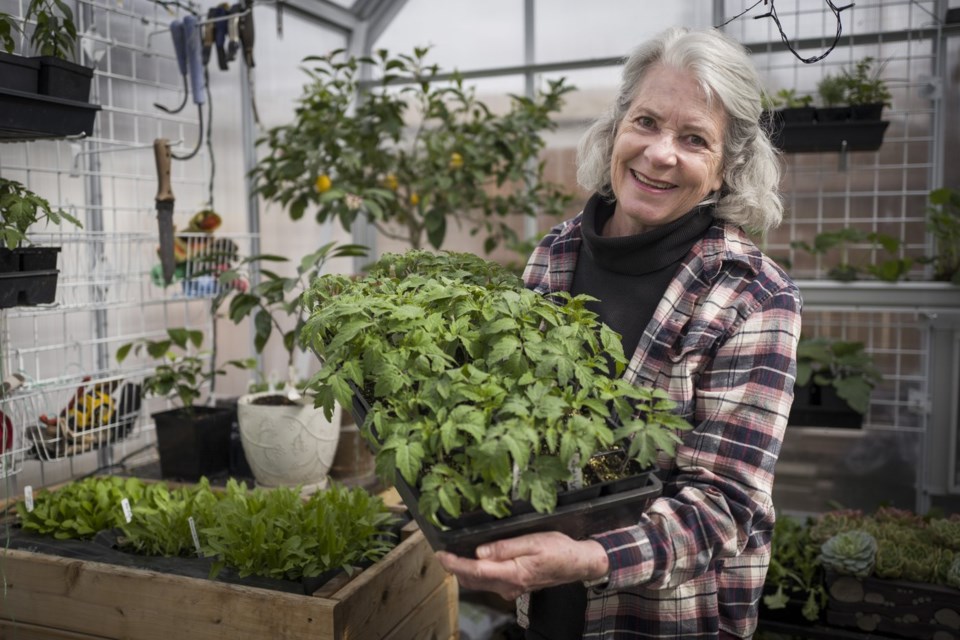CALGARY — The snow has only just melted in Calgary, but strawberries, eggplants, several kinds of tomatoes and even Meyer lemons are growing behind Donna Balzer's bungalow.
Instead of buying a bag of dull spinach from the grocery store, she can go to her greenhouse and pick pert leaves with a glossy sheen — a sign they're abundant in minerals. And instead of a bunch of store-bought herbs that will mostly go limp after a few sprigs are used, she can pick what she needs when she needs it.
"It's never a bad time to have fresh basil leaf. It's never a bad time for fresh rosemary," she says.
With grocery prices surging, it may be tempting for newbies to take a crack at growing their own produce. Gardening aficionados say cost savings are possible, but it takes patience and planning.
Balzer, a horticulturalist who teaches and writes about all things gardening, spent about $20,000 on a backyard greenhouse, an investment she says made sense after she moved from British Columbia to a smaller home. With her children grown, there was also ample time for the project, which she thinks of as an extension to her house.
"It's really worthwhile for me to have the greenhouse and it's so much more than just a place to grow plants," she says, sitting in a patio chair as warm April light streams in through the glass.
Another "perfect splurge" was the $1,500 grow light setup she has in her basement, where trays upon trays of new plants are set out on two shelving units on wheels. While others may start seeds in a haphazard way with random reused containers, Balzer opted to spend on sturdy plastic containers of a standard size for efficiency's sake.
For those who don't have the time and expertise, Balzer recommends keeping focused on one or two items they love.
"The worst thing is to get a seed catalogue and go through and get one of every category. Like, 'I want endive, I want cilantro,'" she said.
"Just pick your favourite category, and maybe it's just herbs. If you can grow amazing basil, just do that and then trade with friends for their amazing tomatoes."
Maggie Wysocki started out as a self-taught home gardener almost 12 years ago and has been documenting her journey on her website From Soil to Soul.
She and her family live on an acreage outside Winnipeg, where they also have a greenhouse, chickens and hardy crops that can survive the tricky Prairie climate.
Wysocki says one of the biggest mistakes she made in the beginning was going to the garden centre without a plan.
"It can be so easy to get excited when you're there and want to buy gadgets and tools and just plants that look exciting and new," she says.
"But in my experience, going there without actually having a solid list of what can fit in my garden and what plants make sense for the little microclimate in my backyard, that's where you're always going to go wrong because you're just going to start overspending."
Wysocki says high-tech gadgets, like probes to gauge soil temperature, aren't usually wise investments.
"We kind of get wrapped up in the idea of thinking that technology is going to tell us how we can garden better," she says. "But I personally think that's kind of missing the whole point of gardening, which is to be out and observing nature and learning from it."
An irrigation system, on the other hand, has been a useful purchase for Wysocki. She also advises that the bulk of a gardener's budget should go toward making sure the soil is healthy, whether that's compost, mulch or a layer of topsoil.
"Your soil health is everything when it comes to your garden. It's the foundation of it all," she says. "So spend the majority of what you've set aside there and then things like seeds and transplants and material, that all should really just take up 15 to 20 per cent of what's set aside to spend."
Wysocki recommends planting crops that have a good return on investment. Instead of a little tomatillo plant that might yield five fruits, potatoes and onions can keep during the winter in cold storage. Tomatoes can be frozen and used in sauces and stews.
She says growing her own food has yielded big savings on her grocery bill, but not right away.
"The reality is really you won't likely save money in your first one to two years of gardening because you're just learning and acquiring those skills and spending and investing money on building your garden's health and ecosystem," Wysocki says.
"But if you keep at it for three, five years onward, I do believe and have seen myself that you gradually see the cost savings."
This report by The Canadian Press was first published April 24, 2025.
Lauren Krugel, The Canadian Press



